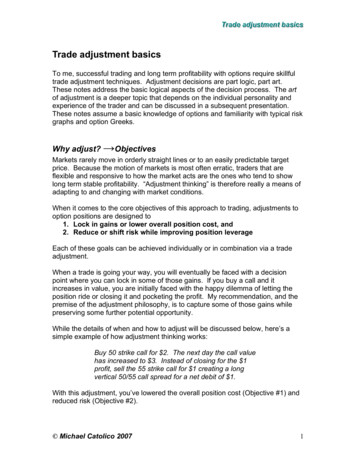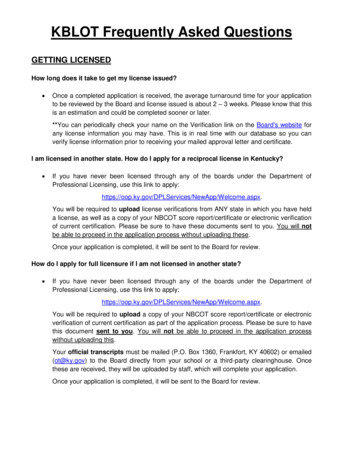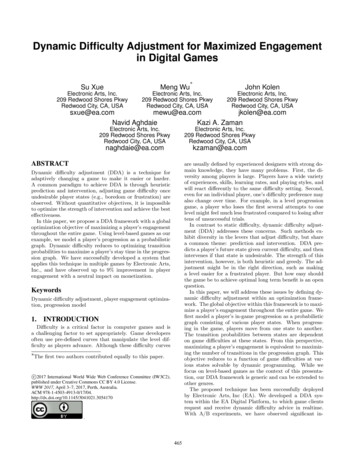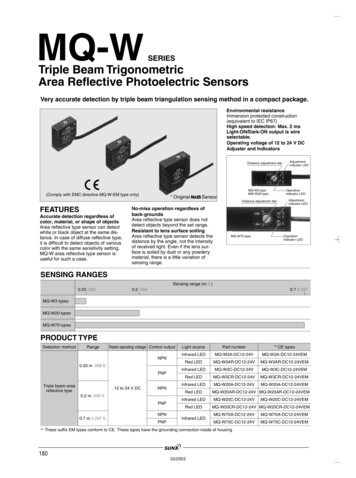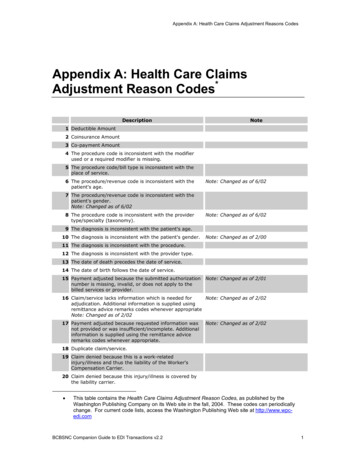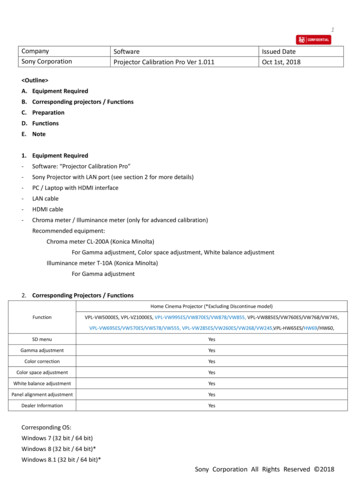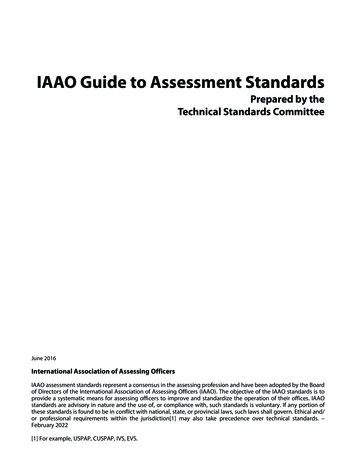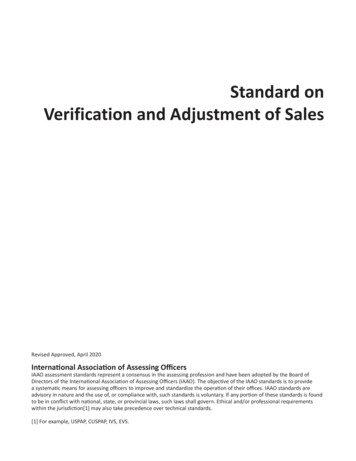
Transcription
STANDARD ON VERIFICATION AND ADJUSTMENT OF SALES - 2020Standard onVerification and Adjustment of SalesRevised Approved, April 2020International Association of Assessing OfficersIAAO assessment standards represent a consensus in the assessing profession and have been adopted by the Board ofDirectors of the International Association of Assessing Officers (IAAO). The objective of the IAAO standards is to providea systematic means for assessing officers to improve and standardize the operation of their offices. IAAO standards areadvisory in nature and the use of, or compliance with, such standards is voluntary. If any portion of these standards is foundto be in conflict with national, state, or provincial laws, such laws shall govern. Ethical and/or professional requirementswithin the jurisdiction[1] may also take precedence over technical standards.[1] For example, USPAP, CUSPAP, IVS, EVS.
STANDARD ON VERIFICATION AND ADJUSTMENT OF SALES - 2020AcknowledgmentsAt the time that the initial draft was started in 2019, the Task Force on the Standard on Verification andAdjustment of Sales comprised chair Carmela Quintos, Ph.D., MAI; members August Dettbarn, Robert Gloudemans,William Marchand, Joshua Myers, and Russ Thimgan; and IAAO liaison Larry Clark.Revision notesThis standard replaces the 2010 Standard on Verification and Adjustment of Sales and is a complete revision.Published byInternational Association of Assessing Officers314 W 10th StKansas City, Missouri 64105-1616816-701-8100Fax: 816-701-8149www.iaao.orgLibrary of Congress Catalog Card Number: ISBN 978-0-88329-254-9Copyright 2019 by the International Association of Assessing OfficersAll rights reserved.No part of this publication may be reproduced in any form, in an electronic retrieval system or otherwise,without the prior written permission of the publisher. IAAO grants permission for copies to be made foreducational use as long as (1) copies are distributed at or below cost, (2) IAAO is identified as the publisher,and (3) proper notice of the copyright is affixed.Produced in the United States of America.1
STANDARD ON VERIFICATION AND ADJUSTMENT OF SALES - 2020Contents1. Scope . 12. Introduction . 13. Sources of Sales Data. 23.1 Real Estate Transfer Documents . 23.2 Sales Verification Questionnaires . 33.3 Parties to the Sale and Third-Party Sources . 34. Data Collection: Useful Sales Information . 44.1 Sale and Deed Information . 44.1.1 Full Consideration. 44.1.2 Date of Transfer. 44.1.3 Legal Description, Address, and Parcel Identifier. 54.1.4 Names of Buyers and Sellers . 54.1.5 Addresses, Phone Numbers, and Other Contact Information of Buyer and .Seller or Their Legal Designee . 54.1.6 Type of Transfer . 54.1.7 Deed Instrument Number . 54.1.8 Unique Sale Number . 54.2 Transaction Conditions . 54.2.1 Interest Transferred . 64.2.2 Type and Terms of Financing. 64.2.3 Relationship of Buyer and Seller . 64.2.4 Method of Marketing . 64.2.5 Time on the Market . 74.3 Property Characteristics . 84.3.1 Property Use . 84.3.2 Personal Property . 84.3.3 GIS Location . 85. Sales Verification . 95.1 Importance of Sales Verification . 105.2 Timeliness of Sales Verification . 105.3 Methods of Sales Verification. 112
STANDARD ON VERIFICATION AND ADJUSTMENT OF SALES - 20205.3.1 Sales Questionnaires and Follow-up Interviews . 115.3.2 Lease Questionnaires (for Commercial Properties) . 125.3.3 Analytical Methods. 135.4 Sales Generally Considered Invalid. 135.4.1 Sales Involving Government Agencies . 145.4.2 Sales Involving Charitable, Religious, or Educational Institutions. 145.4.3 Sales Involving Financial Institution as Buyer. 145.4.4 Sales Involving Financial Institution as Seller . 145.4.5 Sales between Relatives or Corporate Affiliates . 145.4.6 Sales Settling an Estate. 155.4.7 Forced Sales Resulting from a Judicial Order . 155.4.8 Sales of Doubtful Title . 155.5 Transaction Conditions . 155.5.1 Sales with Special Conditions . 155.5.2 Acquisitions or Divestments by Large Property Owners . 165.5.3 Internal Revenue Code Section1031 Exchanges . 165.5.4 Adjoining Property Owners . 175.5.5 Leasebacks . 175.5.6 Short Sales . 175.6 Property Conditions . 175.6.1 Lease Contracts . 185.6.2 Multiple-Parcel Sales . 225.6.3 Property Characteristic Changes . 235.6.4 Property Change in Use . 236. Adjustments. 236.1 Transactional Adjustments . 246.1.1 Buyer’s Closing Costs (Paid by Seller) . 246.1.2 Delinquent Taxes (Paid by Buyer) . 246.1.3 Financing . 246.1.4 Real Estate Commissions . 276.2 Property Conditions Adjustments . 276.2.1 Assumed Long-Term Leases . 273
STANDARD ON VERIFICATION AND ADJUSTMENT OF SALES - 20206.2.2 Personal Property . 296.2.3 Repair Allowances . 306.2.4 Special Assessments . 306.3 Market/Time Adjustments . 307. Documenting the Results of the Verification Process . 317.1 Sale Verification Form . 317.2 Lease Verification Form (for commercial properties) . 328. References . 33Glossary . 34Appendix A. Sales Verification Questionnaire . 48Appendix B.1. Lease Verification Questionnaire (Unit Level) . 49Appendix B.2. Lease Verification Questionnaire (by Use) . 50Appendix C. Questions for Specific Situations. 51Appendix D. Partial Listing of Governmental Agencies . 53Appendix E. Multiple-Parcel Form . 54Appendix F. Sale Verification Form . 55Appendix G.1. Lease Verification Form (Unit Level). 56Appendix G.2. Lease Verification Form (by Use) . 57Appendix H. Intangible Personal Property in Operating Properties . 58Appendix I. Nonrealty Verification Form . 594
STANDARD ON VERIFICATION AND ADJUSTMENT OF SALES - 2020STANDARD ON VERIFICATION AND ADJUSTMENT OF SALES1. SCOPEThe primary responsibility of the assessor is to estimate the market value of each property within thejurisdiction. The integrity of the property tax is dependent on the accuracy of these estimates of marketvalue. This is accomplished by analyzing market data to determine the price that the property beingappraised would probably bring in the marketplace on the date of appraisal. Appraisal accuracy refers tothe degree to which properties are appraised at market value, as defined by professional standards (see theIAAO Glossary for Property Appraisal and Assessment [IAAO 2013a] and the IAAO Standard on RatioStudies [IAAO 2013b]). This standard provides guidance to ensure that only sales that meet the definitionof market value and that have been adjusted for any monies (including financing) not attributable to the realestate are used in developing these estimates of market value. Accuracy is dependent upon properverification and adjustment of sales data.The key principles discussed in this standard that would enable a jurisdiction to conduct proper verificationand adjustment of sales are as follows.Principles There must be a system of record that tracks and digitally stores information collected from realestate transfer documents (such as deeds, sales contracts, and transfer affidavits), salesquestionnaires, follow-up interviews, and third-party sources. Data collection must be administered in a consistent and timely manner, and data collected mustbe as comprehensive and accurate as possible to ensure that there is sufficient information to verifythat the sale price reflects the market value of the real property being transferred and to determineadjustments to the price if necessary. Sales verification should be performed in a timely, uniform, and transparent manner with guidanceon when a sale should be considered valid and what methodologies are acceptable for the validationprocess. Adjustments to the sale price should be performed with the goal of representing only the value ofthe real property transferred in a manner that is consistent and transparent and that documents howadjustments are derived and the sources used. The results of the verification and adjustment process should be documented in a timely manner tolimit the loss of information, comprehensive to inform the results of verification and derivation ofadjustments, stored preferably in electronic format, and completed for all sales that have hadquestionnaires and follow-up interviews and for which usable information has been received.In the following major sections, the principles that are covered in that section are stated and then followedby a discussion of those principles.2. INTRODUCTIONSales data should be collected, verified, and adjusted as necessary for model calibration and ratio studypurposes. In some cases, sales may be valid for model calibration but should not be considered valid forratio study purposes. A verified sale is more reliable than an unverified sale.In jurisdictions that do not have laws mandating full disclosure of sales data, assessing officials work undera severe handicap and should seek legislation that provides for such disclosure (see the results of the 2013Survey of Ratio Study Practices [Technical Standards Committee 2015]). In addition, jurisdictions that havedisclosure but not adequate sale disclosure documents should work toward that goal. The terminology fordetermining whether a sale meets the definition of a valid transaction differs throughout the industry1
STANDARD ON VERIFICATION AND ADJUSTMENT OF SALES - 2020(validation, verification, confirmation, qualification, screening, and so on); however, for this standard, theterm verification is used. It is important to remember that all sales should be considered candidates for validsales unless sufficient information can be documented to show otherwise. While it is imperative that salesbe verified uniformly and accurately, it is also important to process and verify sales in a timely manner sothey are available for analysis. Sales should be trimmed for outliers during the statistical phase, not duringthe verification phase of a mass appraisal or sales ratio study program.3. SOURCES OF SALES DATAThe primary sources of sales data include real estate transfer documents, sales verification questionnaires,parties to the transaction, and third-party sources. The information collected from these sources is enteredinto the system of record that serves as the database for the proper verification and adjustment of sales.Principles in this standard that guide a jurisdiction in the creation and administration of a sales database areas follows.Principles Jurisdictions that record real estate transfer documents have an essential database that trackschanges in property ownership, the type of interest transferred, the rights conveyed, and otherconditions specific to the transaction and property at the time of sale. Jurisdictions that further require a sales verification form to accompany recording of the realestate transfer document can significantly shorten the sales verification process by reducing theneed for follow-up interviews and third-party sources. When data collected from follow-up interviews and third-party sources are entered into thesystem of records, they must be verified and noted for their reliability as a data source.3.1 Real Estate Transfer DocumentsReal estate transfer documents include deeds, sales contracts, and transfer affidavits (i.e., land contracts,contract for deed) completed at the time of sale. Some jurisdictions require recordation of transferdocuments, and some do not (see Ratio Study Practices in the United States and Canada: Results of 2013Survey [Technical Standards Committee 2015]). In the sale verification process, the transfer document mustbe reviewed for the type of interest transferred, the rights conveyed, and other conditions that could affectthe arm’s-length nature of the sale.Common transfer documents used to convey real property are as follows:2 A deed is a written legal instrument that, when duly executed, conveys an interest in the legal titleto a property. The general warranty deed provides the highest level of protection to the buyer and establishes thatthe seller owns the property and has the legal right to sell it. Unless stated specifically in the deed,the property is free of any liens or encumbrances; the buyer is guaranteed the title will stand againstthird parties attempting to establish title to the property; and the seller promises, in order to makethe title good, he or she will deliver any document or instrument necessary. A special warranty deed is not nearly as protective as the general warranty deed in that the sellerwarrants he or she has received title and ensures the property was not encumbered during his or herownership. Bargain and sale deeds implicitly or explicitly assert the grantor’s ownership of the propertyconveyed, but they make no guarantee to defend the title. They provide the grantee with more
STANDARD ON VERIFICATION AND ADJUSTMENT OF SALES - 2020protection than a quitclaim deed but less than a special warranty deed. The words of conveyance“bargain and sale” distinguish a bargain and sale deed. A deed in which the grantor conveys or relinquishes all interests in a property without warrant asto the extent or validity of such interests is known as a quitclaim deed. The quitclaim deed is theleast protective deed for the buyer and conveys only whatever rights or interests the grantor has inthe property. There are no warranties or covenants to the buyer. If the grantor has a good title, it isas good as the warranty deed; however, there are no warranties or guarantees. Tax deeds are deeds by which title to real property, sold to discharge delinquent taxes, is transferredby a tax collector or other authorized officer of the law to the purchaser at a tax sale. Sheriff deeds are deeds that give ownership rights in property bought at a sheriff’s sale. A sheriff’ssale is a sale conducted by a sheriff or authorized officer of the court upon order of a court after thelegal owner of the property fails to pay a judgment. Often the property is involved in a mortgageforeclosure action or is subject to a mechanics lien incurred by a failure to pay for labor andmaterials to improve the property. Trust deeds transfer the title to the property to a trustee to be held in trust. These deeds are alsoknown as deeds of trust. There are three parties involved in a deed of trust: the trustor (borrower),trustee (holder of the legal title), and the beneficiary (lender). The trustee holds the power of salein the event of default. Land contracts are executory contracts for the purchase of real property under the terms of whichlegal title to the property is retained by the seller until such time as all the conditions stated in thecontract have been fulfilled. These contracts are commonly used for the installment purchase ofreal property and are often referred to as a contract for deed. The actual deed is not recorded untilthe title passes to the buyer upon fulfillment of the contract.3.2 Sales Verification QuestionnairesSales verification questionnaires, which can be written or in electronic format, are affirmed or swornstatements regarding the sale of the property. Typically, these forms are required to be completed prior torecordation of the deed. A more comprehensive questionnaire may limit the need for follow-up verificationof the sale. (See Appendix A for a copy of a sales verification questionnaire. Also, refer to the ratio studysurvey results [Technical Standards Committee 2015] for the number of jurisdictions currently using acomprehensive sales verification form.) A set of instructions for completing the form should accompany orbe a part of the questionnaire.3.3 Parties to the Sale and Third-Party SourcesBuyers and sellers of real property should be contacted directly to secure or confirm sales data. When buyersor sellers are parties to the sale, it is important to contact all parties to verify agreement on the data.Third-party sources are a source of sales data and are especially important when transfer and disclosuredocuments do not provide full disclosure or omit important data. The following is a partial listing of thirdparty sources: Multiple listing servicesTitle companiesFinancial institutionsLeasing agenciesProperty managersReal estate brokers and agenciesGovernment and private fee appraisers3
STANDARD ON VERIFICATION AND ADJUSTMENT OF SALES - 2020 AttorneysAppraisal organizations.4. DATA COLLECTION: USEFUL SALES INFORMATIONThe goal of data collection is to ensure that the database contains sufficient information to verify that thesale occurred as an arm’s-length transaction and that the sale price reflects the market value of the realproperty transferred. A primary task in developing a comprehensive database is to identify the relevantsales data information that should be collected.Principles A sales database should contain the factual information of the sale: full consideration, date oftransfer, property legal description, buyer and seller names and addresses, and the type of transferdocument used to convey the property (see Section 3.1). Jurisdictions that require a sales questionnaire should structure the questions to capture thetransaction conditions helpful in determining the arm’s-length nature of the sale. The sales questionnaire should also have questions on the property characteristics at the time ofsale to determine whether the sale sold before or after any significant repairs or renovations, toisolate the value of the real property being transferred, and to determine whether adjustments arewarranted for lease contracts.These data elements should be maintained in a separate data file or sales history file component of acomputer-assisted mass appraisal (CAMA) system. In addition, the file should include information usefulfor stratification and other analytical purposes. Sales data files should reflect the physical characteristics ofthe property at the time of sale. If significant legal, physical, or economic changes have occurred betweenthe sale date and the assessment date, the sale should not be used for ratio studies. The sale may still bevalid for mass appraisal modeling by matching the sale price against the characteristics that existed on thedate of sale.4.1 Sale and Deed InformationIt is important to document and verify the sale transaction and obtain information on the type of deedassociated with the sale.4.1.1 Full ConsiderationFull consideration is the total amount paid for the property, including the cash down payment and amountsfinanced. The actual sale price is the most essential item of information concerning the sale, and its accuracyshould be carefully scrutinized. In many jurisdictions it is common practice in deeds of conveyance to stateconsiderations in terms such as “one dollar plus other due and just consideration.” These amounts are rarelythe actual selling price and should be ignored in favor of information from the buyer and seller or otherreliable source, such as sales verification questionnaires.4.1.2 Date of TransferThis is the date on which the sale was closed or completed. Not all jurisdictions require recordation ofdeeds; therefore, the deed date should be considered the most reliable date of sale, not the recording date.If a copy of the deed is not available, the date on the sales verification questionnaire should be used.4
STANDARD ON VERIFICATION AND ADJUSTMENT OF SALES - 20204.1.3 Legal Description, Address, and Parcel IdentifierEach parcel should be assigned a unique parcel identifier (see Standard on Digital Cadastral Maps andParcel Identifiers [IAAO 2015]. If this number is noted on the document at the time it is recorded, theassessor can locate the parcel in the file directly. This information links the sale to the assessor’s recordsand identifies the property’s location. Without careful matching of the parcel identifier with the legaldescription, the wrong appraised or assessed value may be used in a ratio study, and the incorrect set ofparcel characteristics may be transferred to the sales history file. The legal description also helps identifyparcel splits, which are not usable in ratio studies. This information also may be used to prevent sales frombeing included twice. The situs address can be useful in locating and confirming the physical location of aparcel in the field.4.1.4 Names of Buyers and SellersThis information permits the assessor to maintain a current record of the owners of all property in thejurisdiction. Transfer documents often refer to the buyer as the grantee or transferee and the seller as thegrantor or transferor.4.1.5 Addresses, Phone Numbers, and Other Contact Information of Buyer and Selleror Their Legal DesigneeThis information helps to identify more positively the parties to the sale. If the buyer will not reside at theproperty, the buyer’s address may be needed for future correspondence. If the seller has established a newad- dress, this information aids the assessor in contacting the seller regarding the sale.4.1.6 Type of TransferThe type of transfer document often helps determine whether the sale is usable. If the source of sales datadoes not include a copy of the transfer document, the type of transfer document should be specificallyrequired. A warranty deed, for example, is generally associated with a usable sale; sheriff’s deeds are not;and quitclaim deeds are questionable, while contracts for deed and certain transfer affidavits may requirean adjustment for financing (see Section 6.1.3).4.1.7 Deed Instrument NumberThe deed instrument or document number, as well as the record or deed book and page, indicates where thedeed is located in the official records and is an important asset in researching sales and leases.4.1.8 Unique Sale NumberA unique sale number can tie a sale validation questionnaire to a particular parcel and eliminate confusionif the parcel sells more than once. A unique number should be assigned to sales verification questionnairescompleted at the time of recordation of the deed. Legislation requiring that the sales verificationquestionnaire be provided at the time of deed recordation provides leverage in ensuring the form iscompleted properly, a unique number is applied, and each transfer is accounted for. For electronic reportingto oversight agencies, this unique number could then be tied to the jurisdiction’s identification number andparcel identification number.4.2 Transaction ConditionsIt is important to verify whether the sale occurred as an arm’s-length transaction or with conditions thatwould require an adjustment to reflect market prices. Information gathered on the interest transferred, thefinancing terms, the relationship between parties, the method of marketing, and the exposure time on the5
STANDARD ON VERIFICATION AND ADJUSTMENT OF SALES - 2020market is useful to determine whether the sale is usable or requires an adjustment prior to use as acomparable sale or in ratio studies.4.2.1 Interest TransferredA transaction that conveys the full rights of ownership to a property is known as a fee simple transfer. Feesimple is defined in land ownership as the complete interest in a property, subject only to governmentalpowers such as eminent domain. (for further clarification on fee simple definition see IAAO position paper- Setting the Record Straight on Fee Simple [IAAO 2015]) Transfers that convey less than full interest arerarely usable in mass appraisal or in ratio studies without adjustments, unless the appraised value and saleprice reflect the same ownership rights. Examples of partial interest transfers include sales involving lifeestates, fractional interest, air rights, and mineral rights.4.2.2 Type and Terms of
Standard on . Verification and Adjustment of Sales . Revised Approved, April 2020. International Association of Assessing Officers. IAAO assessment standards represent a consensus in the assessing profession and have been adopted by the Board of
